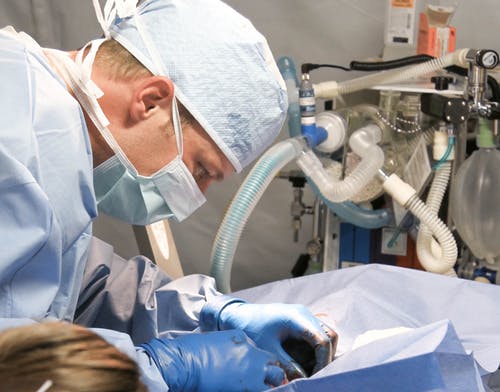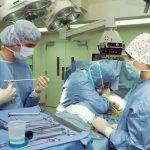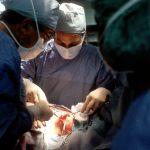Which is The Right Skin Cancer Surgery for You?

Thanks to the many advances in skin cancer surgeries, the five-year survival rate for people who detect melanoma early is close to 98 percent. However, since not all skin cancers are the same, the type of treatment that is needed differs from person to person. It’s important that you immediately seek consultation and visit a medical professional as soon as you notice any signs of the disease. The highly skilled team at Benrus Surgical has years of experience in general surgery and specializes in treating all skin cancers including melanoma. Come visit us and we can work with you to find the best treatment to beat this disease. Some of the treatments offered include:
Excision – Local anesthesia is usually used for this procedure, which consists of a surgeon using a razor or scalpel to shave or cut the growth off. The three main types of excision are:
When it comes to skin cancer surgery, finding the right procedure for you such as surgical excision or lymph node dissection can be a crucial decision. With different options available on the website, it’s important to understand the contrasting approaches and choose the one that best suits your needs and doctors.
Whether you’re dealing with basal cell carcinoma, squamous cell carcinoma, or melanoma, understanding the differences in surgical techniques for cancerous skin, skin flaps, normal skin, and nearby skin is essential for making an informed decision about your treatment.
From Mohs surgery, which offers high precision and minimal scarring for cancerous skin, to excisional surgery, which involves removing the tumor along with some surrounding healthy tissue, we’ll delve into each option’s benefits and considerations with doctors in the lab. By providing insights into success rates, recovery times, and potential side effects, we aim to equip you with the knowledge necessary to make an educated choice about your skin cancer surgery.

Let’s dive in, doctors, and explore which skin cancer surgery might be right for you on our website.
Understanding Skin Cancer Surgery
When it comes to treating skin cancer, doctors often recommend surgery as the most effective option. There are different types of skin cancer surgeries available, each with its own advantages and disadvantages, according to doctors. One common type of surgery is Mohs surgery, which is known for its high cure rate and tissue preservation.
Surgery Types
Mohs surgery is a specialized procedure that involves removing layers of cancerous tissue while sparing as much nearby healthy skin as possible. This technique allows doctors for precise removal of basal cell carcinoma and squamous cell carcinoma, two common types of skin cancer. The removed tissue is immediately examined under a microscope to ensure complete removal of the cancer cells. This process continues until no more cancer cells are detected.
In addition to Mohs surgery, there are other surgical options available for treating skin cancer. These include excisional surgery, where the tumor and a margin of healthy skin are removed, and cryosurgery, which involves freezing the cancerous tissue. Radiation therapy and chemotherapy may also be used in certain cases.
Choosing the Right Procedure
When deciding on the appropriate skin cancer surgery, several factors need to be considered. It is important to consult with a dermatologist or surgeon who specializes in skin cancer treatment. They will assess various aspects such as the type of skin cancer, its size and location, as well as your overall health condition.
A personalized approach is crucial in selecting the right procedure for you. Factors such as age and general health play a role in determining the most suitable treatment option. For instance, older individuals or those with underlying medical conditions may require less invasive procedures. On the other hand, younger patients with aggressive forms of skin cancer may benefit from more extensive surgeries.
Factors to Consideration
The size and location of the tumor also influence the choice of surgery. Smaller tumors located on less critical areas of the body may be treated with simpler excisional surgeries or cryosurgery. However, larger tumors or those in delicate areas such as the face or genitals may require more complex procedures like Mohs surgery to ensure complete removal while preserving aesthetics and function.
Before undergoing any skin cancer surgery, it is important to have a thorough discussion with your healthcare provider. They will explain the potential risks and benefits associated with each procedure. This will help you make an informed decision about the best course of action for your specific situation.
Mohs Surgery Deep Dive
Why Mohs
Mohs surgery is often the preferred treatment for certain types of skin cancers. The technique offers several advantages over traditional excision methods. One of the main reasons why Mohs surgery is favored is its high cure rate. The procedure boasts a success rate of up to 99% for certain types of skin cancer, making it an excellent choice for patients looking for effective treatment options.
Another benefit of Mohs surgery is its ability to preserve healthy tissue while removing cancerous cells. Traditional excision methods involve removing a larger area of healthy skin around the tumor to ensure all cancer cells are eliminated. In contrast, Mohs surgery allows for precise removal of cancerous tissue while minimizing damage to surrounding healthy skin. This targeted approach not only improves cosmetic outcomes but also reduces the risk of complications during healing.

Mohs Procedure
Preparation
Before undergoing Mohs surgery, there are some important preparations that patients need to follow. These instructions typically include guidelines on medications, such as blood thinners, that may need to be temporarily stopped prior to the procedure. Patients may also be advised to avoid certain supplements or herbal remedies that can increase bleeding risk.
It’s crucial for patients to understand what to expect before the Mohs procedure. This includes information on how long the surgery may take and whether local anesthesia will be used. Patients should also be aware of any specific pre-operative requirements, such as fasting before the procedure.
During Surgery
During the Mohs surgery procedure, the Mohs surgeon follows a step-by-step process to remove cancerous tissue layer by layer. Each layer is examined under a microscope in real-time, allowing the surgeon to precisely identify and remove all cancer cells while sparing healthy tissue.
The role of the Mohs surgeon during the procedure is crucial in ensuring successful outcomes. They carefully analyze each layer of tissue to determine if cancer cells are still present. If cancer cells are detected, the surgeon continues to remove additional layers until no cancer cells remain.
To ensure patient comfort during surgery, local anesthesia is administered in the surgical area. This helps numb the skin and minimize any discomfort or pain. The use of local anesthesia also allows patients to remain awake during the procedure, reducing the risks associated with general anesthesia.
Post-Procedure
After Mohs surgery, immediate post-operative care is essential for optimal healing and recovery. Patients can expect some swelling, bruising, and discomfort at the surgical site. Monitoring for any signs of complications, such as excessive bleeding or infection, is crucial during this time.
Patients will receive specific instructions for wound care, including how to clean and dress the surgical site. It’s important to follow these instructions carefully to promote proper healing and minimize scarring. Follow-up appointments will also be scheduled to monitor progress and ensure that the surgical site is healing well.
Care After Mohs
Following Mohs surgery, long-term care recommendations are important to maintain overall skin health and prevent future skin cancers. One of the key aspects of care after Mohs surgery is sun protection. Wearing sunscreen with a high SPF, seeking shade during peak sun hours, and wearing protective clothing can help reduce the risk of developing new skin cancers.
In addition to sun protection, skincare post-Mohs procedure should focus on gentle cleansing and moisturizing of the surgical site. Using mild cleansers and fragrance-free moisturizers can help promote healing and minimize irritation.
If any side effects or complications arise after Mohs surgery, it’s important to promptly consult with the healthcare provider. They can provide appropriate guidance and treatment options tailored to individual needs.
Reconstruction Post-Mohs
After Moh
Wide Local Excision Insights
Procedure Explained
Wide local excision, also known as surgical excision, is a common procedure used to remove skin cancer. During this surgery, the tumor along with some surrounding healthy tissue is removed. The goal of wide local excision is to completely remove the cancerous cells while minimizing damage to the surrounding tissue.
The procedure begins with the administration of local anesthetic to numb the area being treated. This ensures that the patient remains comfortable throughout the surgery. Once the anesthesia takes effect, the surgeon proceeds to make an incision around the tumor site. The size of the incision depends on various factors such as the type and stage of cancer.
After making the initial incision, the surgeon carefully removes both the visible tumor and a margin of healthy tissue surrounding it. This margin acts as a safety measure to ensure that all cancer cells have been eliminated. The amount of healthy tissue removed depends on factors such as the size and location of the tumor.
Once the tumor and surrounding tissue have been excised, the surgeon closes the incision using sutures or other closure methods. In some cases, a skin graft or flap may be necessary for larger excisions.
Importance of Microscopic Examination in Wide Local Excision
One of the key aspects of wide local excision is microscopic examination. After removing the tumor, it is sent to a laboratory for analysis. Here, trained pathologists examine thin slices of tissue under a microscope to determine if any cancer cells remain at the margins.
This microscopic examination plays a crucial role in ensuring that all cancer cells have been removed during surgery. If cancer cells are found at the margins, further treatment may be required to eliminate them completely.
Benefits of Wide Local Excision for Precise Cancer Removal
Wide local excision offers several benefits when it comes to removing skin cancer precisely. Firstly, it allows for targeted removal of the tumor and a margin of surrounding tissue. This helps to ensure that all cancer cells are eliminated, reducing the risk of recurrence.
Furthermore, wide local excision offers good cosmetic outcomes as it aims to preserve as much healthy tissue as possible. By removing only a margin of healthy tissue around the tumor, the procedure minimizes scarring and disfigurement.
Wide local excision is also a versatile procedure that can be used to treat various types and stages of skin cancer. Whether it’s basal cell carcinoma, squamous cell carcinoma, or melanoma, this surgical technique can be tailored to individual cases for optimal results.
- Shave Biopsy – A razor-like tool is used to peel or shave off the growth from the skin.
- Simple Excision – A scalpel is used cut off the growth and skin that surrounds it.
- Wide Excision – This procedure is used when a wider perimeter of skin needs to be cutoff. Sometimes a deeper cut into the tissue will also need to be made.Lymph Node Biopsy – Patients with melanoma may need to have this procedure preformed to see is there are any signs of cancer in the nodes or lymph nodes to help determine if further treatments are needed.Benrus Surgical not only specializes in skin cancer surgeries, but they also preform hernia repair and treat gallbladder disease and appendicitis. If you need general surgery in the St. Louis area, contact us for an appointment today!
